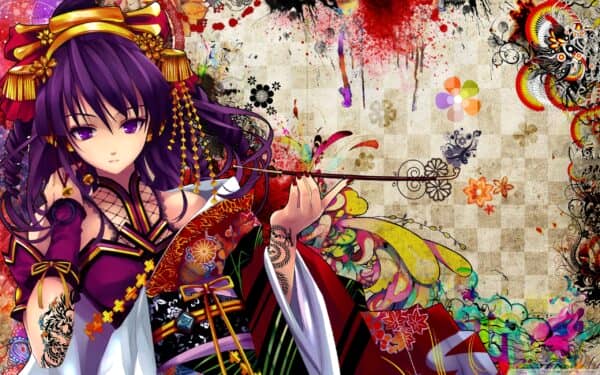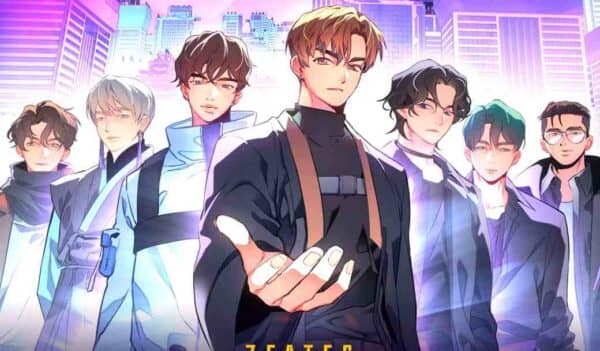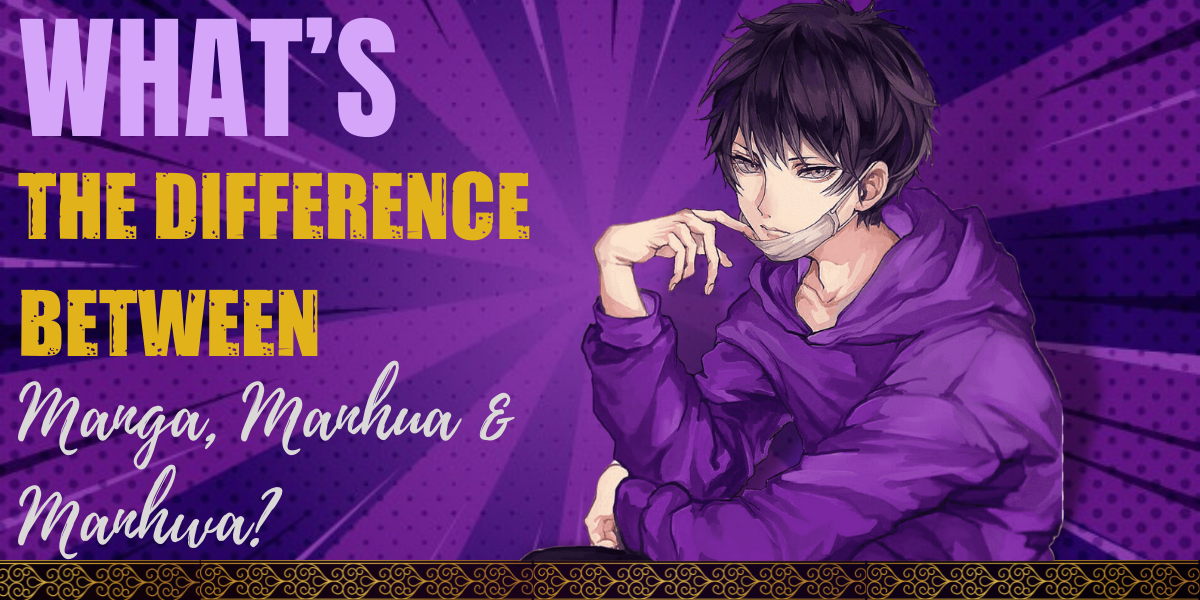We all know about manga, but if you’re not familiar with other East Asian comics, the terms manhwa and manhua might be new to you.
Although they’re all comics, manga, manhwa, and manhua, they all come from different parts of Asia, and they’re pretty unique from one another once you look under the surface.
Manga, Manhua & Manhwa: What’s The Difference?
In this post, you’ll find everything you need to know about manga, manhua & manhwa. I’ll demystify the terms and explain their key differences and similarities, so next time you head to the comic book store, you’ll know exactly what to look for.
Manga, Manhua & Manhwa: Etymology
Before we begin, let’s nail down these three terms and look at their origins.
Manga comes from Japan, manhwa is Korean, and manhua hails from China, Taiwan, or Hong Kong.
The Japanese word “manga” and the Korean word “manhwa” are both derived from the Chinese “manhua,” which translates roughly as “impromptu sketches.”
Before these art forms gained global popularity, the terms were often used interchangeably to describe all types of comics and graphic novels, no matter where they came from. But these days, due to a rapidly growing international readership, the definitions have become more fixed in order to designate the comic’s country of origin.
Before these art forms gained global popularity, the terms were often used interchangeably to describe all types of comics and graphic novels, no matter where they came from. But these days, due to a rapidly growing international readership, the definitions have become more fixed in order to designate the comic’s country of origin.
1. Manga

Manga is Japan’s biggest export. NO matter where you’re from the world, you’re probably familiar with those iconic illustrations featuring cartoonish characters with oversized eyes.
The art form first gained traction in the nineteenth century, but its famous imagery is inspired by much earlier Japanese art.
Manga: What Makes it Unique?
The most noticeable feature that sets manga apart from manhwa and manhua is its monochrome format. While you sometimes find full-color front covers, manga is almost universally published in black and white.
The layout is designed to be read from right to left, and as you’d expect, all original manga is written in Japanese. But these days, thanks to a huge international fanbase, many famous series are now translated into multiple languages for a global audience.
When a manga is released, it’s traditionally published in weekly magazines, such as Shonen Jump, Shueisha, and Kodansha, but monthly manga publications have also become popular in recent years.
Once a series becomes established, and multiple chapters are developed, issues are often compiled into complete volumes. Hence, there’s no need to collect every original publication to follow the story.
A manga creator is known as a “mangaka,” but since a series can span years, if not decades, multiple mangakas often work on the same manga. Plus, these gripping stories paired with intricate artwork require a whole team to see it through to publication, so there are usually plenty of non-mangakas working behind the scenes too.
Also Read: The 7 Best Sites and Apps to Read Manga
The Rise Of Manga
Manga generates a massive amount of revenue for the Japanese economy. Over the last three decades, its popularity has spread around the world, first to the US and Canada, then across Europe, and now, readers can be found in every corner of the globe.
In fact, manga now outsells any other type of comic or graphic novel in the United States, and the same is true elsewhere too.
Because manga is such big business, aspiring artists and writers train at universities across Japan, all competing to be the best in their field.
Many creatives have also made the transition from manga to another major modern Japanese artform anime. In fact, the majority of anime is based on an original manga publication, such as the smash-hit Fullmetal series and Demon Slayer Mugen.
Also Read: Manga Like One Punch Man: 8 Best Options
Manga Genres
There are hundreds of genres in the manga world, meaning there is something to suit every reader, regardless of their age or interests.
So, as there are too many to cover in this post, here are a few popular ones.
- Shônen
Shônen manga is traditionally aimed at adolescent boys, but thanks to a recent shift in attitudes around traditional gender roles, many young girls are also reading shônen these days. That being said, the main character is still almost always male.
Shônen is all about high-action scenes and epic adventures, and it often incorporates elements of light horror and violence.
- Shôjo
The majority of readers of this manga genre are teenage girls, which makes sense since Shôjo takes its name from a Japanese word meaning “young girl.”
Shôjo is less about action and adventure and more about emotional issues and relationships between friends and couples.
The artwork is highly idealized with plenty of bold, feminine symbols such as hearts and flowers, which are used to display the feelings of the characters within the stories.
- Seinen
The word “seinen” means “youth,” but this is a much more adult-focused genre than Shônen and Shôjo. Readers tend to be males aged between 18 and 30, and some seinen publications also attract a fanbase of businessmen in their 40s and beyond.
All kinds of themes can be found within the seinen genre, from science fiction to pornography. The storylines usually feature grittier subject matters, and they put much more focus on character and plot development than the more simplistic high-action shonen manga.
- Josei
Josei manga is a kind of grown-up version of shôjo. While it still features themes of friendship and romance and focuses on emotion rather than action, the artwork is less idealized, the characters are more complex, and the plot contains more mature and challenging themes.
- Shoujo-ai and Shounen-ai
Also known as yuri and yaoi, these two genres focus on LGBTQ+ relationships. Subject matters and themes within these genres are broad, and so while some stories are strictly romantic, many are packed full of action and adventure, horror and violence, and everything in between.
2. Manhwa

Korean manhwa might not be as well known and celebrated as manga, but there are still plenty of popular titles that have made it outside of Korean shores. And its popularity with international audiences is growing by the day, especially among manga fans who are looking to branch out into something new.
Manhwa is its own entity, but its origins are firmly rooted in manga and date back when Korea was still under Japanese occupation in the early part of the 20th century.
Yet manhwa’s success didn’t happen overnight, and it took until the 1950s and 60s until it really took off around Korea.
This is partly because, during the Japanese occupation, some political manhwa was considered highly controversial, and the government even attempted to outlaw the artform completely. Censorship remained in force for years, which helps to explain manhwa’s slow rise to popularity both within Korea and on the international stage.
Manhwa enjoyed its first major boom in the 2010s, with the rise of online comic sharing sites such as Lezhin and LINE Webtoon. Suddenly, Koreans had access to a huge array of previously hard-to-find publications, giving rise to a whole new generation of fans.Manhwa enjoyed its first major boom in the 2010s, with the rise of online comic sharing sites such as Lezhin and LINE Webtoon. Suddenly, Koreans had access to a huge array of previously hard-to-find publications, giving rise to a whole new generation of fans.
This digital-only trend has continued to this day, so much so that most manhwa is found exclusively online rather than in print.
Manhwa: What Makes It Unique?
These comics and graphic novels share many of the same characteristics as Japanese manga, but there are some key differences too.
One of the most notable is that manhwa is read from left to right, just like English language comics and graphic novels. This makes it easier for Western audiences who are more accustomed to this format, but it’s something to consider if you’re already used to reading manga.
All original manhwa is published in Korean, but many of the most popular series are translated into various other languages too.
That being said, manhwa is still up and coming outside of Asia. And as the international fan base is growing by the day, there’s nowhere near the number of English language publications on offer as there is in the manga world.
Manhwa artists are known as “manhwaga,” and the illustration style they use is quite different from the polished finish found in most manga. Characters are still depicted with large, cartoonish eyes, but they generally appear more realistic and less stylized.
Another key difference; unlike manga, manhwa is often produced in full color, especially when it’s published online as a webtoon (which is more often than not).
Also Read: 5 Favourite Sites To Read Comic Books Online
What Are Webtoons?
Some people use the terms “webtoons” and “manhwa” interchangeably, but strictly speaking; they’re not the same thing.
A webtoon is a full-color manhwa exclusively available in digital format. These days, webtoons are the most popular form of manhwa, and most traditional in-print manhwa is reserved for serious collectors.
3. Manhua
The final entry in this list of East Asian exports is manhua, which are comics created exclusively in China, Taiwan, or Hong Kong.
The first published manhua was the 1904 “Current Affairs Comics’, which offered a commentary on war and politics of the time. Over the next two decades, this new art form began to lay down its roots, and in 1928, the first-ever dedicated manhua magazine, Shanghai Sketch, was born.
The magazine sparked a small yet thriving manhua scene in both mainland China and Hong Kong, and by the mid-1950s, a second popular publication, Cartoons World, entered the market. This introduced a whole new generation of fans to manhua and solidified it as an important part of national culture.
But just like Korea’s manhwa, manhua has fallen victim to governmental suppression and control over the years, and since the birth of the internet, many satirical or controversial comics have been censored and removed.
Manhua: What Makes it Unique?
Manhua comics and graphic novels can be read from either left to right or right to left, depending on where they come from. Generally speaking, manhua produced in mainland China is read from left to right, and those hailing from Hong Kong or Taiwan are read from right to left.
A person who creates manhua is called a “manhuajia,” and just like Korean manhwagas, a manhuajia depicts their characters in a more realistic and less stylized fashion than their Japanese counterparts.
Manhua comics tend to be produced in full color rather than black and white, especially in their more popular digitized formats. And in recent years, manhua has taken on a brand new animated form through series such as Yi Ren Zhi Xia and Soul Buster.
Manhua is becoming more and more popular by the day, and there’s a growing demand for these comics and graphic novels around the world.
But unlike the diverse themes of manga and manhwa, manhua generally falls into one of just four categories; politics, comedy, action, and kids, so whether it will ever rival the success of manga remains to be seen.
The Key Differences Between Manga, Manhua, And Manhwa
Here’s a recap of some of the major differences between these East Asian publications.
- Manga is from Japan, Manhwa is from South Korea, and manhua hails from China, Hong Kong, and Taiwan.Manga is read from right to left, whereas manhwa is read from left to right, and manhua varies depending on its place of origin.
- Manga artists depict characters highly stylized, whereas manhwa and manhua comics feature more realistic-looking characters.
- Manga is published almost exclusively in black and white, whereas manhwa and manhua can frequently be found in full-color formats, especially online.
- Multiple manga issues are often collected into chapters and sold as volumes. In contrast, manhua and manhwa are almost always stand-alone and published weekly on webtoon platforms or in print.
Conclusion
There’s no doubt that manga has taken the world by storm, but these days, manhwa and manhua are also making waves in the global comic book scene.
These three East Asian exports share plenty of similarities, but as we’ve discovered, there are some pretty important differences between them too.
If you were puzzled by the differences between manga, manhwa, and manhua, I hope this post has helped clear up any confusion.
Are you a fan of manga, manhwa, and manhua? If so, which is your favorite and why? Let me know in the comments below!




Thank you for an interesting summary of Manga, Manhua and Manhwa.